Immerse yourself in unforgettable Jaisalmer desert adventures, in a mesmerizing destination renowned for its historic forts, vibrant culture, stunning architecture, and thrilling desert escapades.

Named after Maharaja Jaisal Singh, Jaisalmer stands as one of Rajasthan’s most iconic historical destinations. Located in the heart of the vast Thar Desert, this city is celebrated for its rich heritage, traditions, and vibrant culture. Jaisalmer district holds the distinction of being the largest in Rajasthan and the third largest in India. Located in the Marwar region (Jodhpur Division), the city serves as the administrative headquarters of the district.
Known as the “Golden City,” Jaisalmer enchants visitors with its golden-hued sandstone architecture, stunning landscapes, and deep cultural roots. The city is adorned with serene lakes, intricate Jain temples, and grand havelis, showcasing its opulent past.
Historically, Jaisalmer was a crucial stop along the ancient camel-train route that connected India with Central Asia. Over time, the city’s fortunes have fluctuated due to regional geopolitics and the development of new trade routes. The rise of sea trade, particularly during the British era, dealt a significant blow to Jaisalmer’s prominence. Despite these changes, Jaisalmer has preserved its charm and continues to captivate those who explore its storied streets.
Must-Visit places in Jaisalmer
Jaisalmer Desert Adventures offers an exclusive and immersive destination experience, distinct from the typical tourist ‘triangle.’ Its smaller size compared to cities like Jaipur and Jodhpur allows for more intimate and unique encounters, cherished by discerning travellers.
Tourism in Jaisalmer revolves around deeply immersing visitors in its rich culture and heritage, rather than merely showcasing monuments. However, there are still some iconic spots in Jaisalmer that are simply unmissable.

Jaisalmer Fort (Sonar Quila)
Jaisalmer Fort, one of the largest forts in the world, stands as the most iconic landmark of Jaisalmer city. Unlike other forts in Rajasthan, this one is a vibrant living monument, housing museums, shops, restaurants, residences, and even hotels within its ancient walls.
Constructed in 1156 under the reign of Rawal Jaiswal, the founder of Jaisalmer, the fort is a proud legacy of the Bhati clan. Rising 250 feet tall and protected by 30-foot-high walls, Jaisalmer Fort boasts an impressive 99 bastions, with 92 of them built between 1633 and 1647. The architecture is a stunning blend of Islamic and Rajput styles. Visitors can enter the fort through four grand gateways: Ganesh Pol, Akshya Pol, Suraj Pol, and Hawa Pol. Perched on Trikuta Hill, this fort has witnessed numerous historic battles.
Inside the fort, the main attractions include the Raj Mahal (Royal Palace), the Jain temples, and the Laxminath Temple. Built to the true Rajasthan standards, the fort presents a striking cityscape against a red-and-yellow backdrop. Often referred to as the “Sonar Kila” or “Golden Fort,” it is made of yellow sandstone that glows with a golden hue when bathed in the early morning sunlight.
Patwon Ki Haveli

In the city of Jaisalmer, Rajasthan stands an architectural gem known as Patwon ki Haveli. Located near the Patwa Valley, this haveli consists of five distinct palaces and is also called the House of the Brocade Merchants, as a prosperous brocade merchant and jeweller, Guman Chand Patwa built it. These five mansions were intended for the five Patwa brothers. Today, one of the havelis hosts guests, while two others are managed by the Archaeological Survey of India. Inside, visitors can find a museum and a shop selling antique furniture.
Constructed from yellow sandstone with a striking brown gateway, the haveli’s walls are adorned with intricate mirrorwork and beautiful paintings. Each arch features a uniquely distinct style, and lattice or jali carvings allow sunlight to beautifully illuminate the interiors. With around 60 balconies, the structure is built in the traditional style of Jaisalmer and is one of the region’s most well-preserved heritage sites.
The mansion complex’s construction began with the first haveli in 1805, and it took 60 years to complete the entire complex in all its splendour. Despite this, the first mansion remains the grandest of them all and was the second haveli ever built in Jaisalmer.
Gadisar Lake
Gadisar Lake is more than just a body of water; it’s a living museum showcasing the rich history and culture of Jaisalmer. Surrounded by splendid monuments, temples, chhatris, and shrines, the lake reflects the artistic and architectural heritage of the city. It also hosts various festivals and events that celebrate Jaisalmer’s traditions and customs, making it a popular attraction for visitors worldwide who come to bask in its charm and tranquillity.
The lake’s fascinating history dates back to the 12th century when it was built by Rawal Jaisal, the founder of Jaisalmer, as a rainwater harvesting reservoir to provide water for his people. Rawal Jaisal, a Bhati Rajput ruler, established Jaisalmer as his capital in 1156 AD after relocating from Lodurva due to water scarcity.
Originally named Jaisalasar or Jasalsar Lake, it was strategically located near the Jaisalmer Fort, serving both as a vital water source and a defensive measure against enemy attacks. Over time, the lake became a cultural hub, with various rulers and nobles constructing temples, chhatris, and shrines around its shores, further enhancing its historical and cultural significance.
Sam Sand Dunes
The Sam Sand Dunes, located about 45 km from Jaisalmer city, are a breathtaking part of the Thar Desert, offering endless stretches of golden sand as far as the eye can see.
Shaped and sculpted by the wind over centuries, these ever-changing dunes form a unique and mesmerizing landscape. Positioned on the outskirts of Jaisalmer, they provide an unforgettable desert experience, a stark contrast to the bustling city life.
Tourists from around the globe flock to the Sam Sand Dunes, often returning for the enchanting scenery. The dunes offer some of the most captivating sunset views imaginable, with the desert bathed in shades of orange, pink, and gold. The magic of this spectacle is best experienced on a camel safari across the vast desert expanse.
Tanot Mata Temple
Tanot Mata is a revered temple located in the Jaisalmer district of Rajasthan, India.
Worshipped as Tanot Mata, Goddess Aavad, the daughter of Mamadji Charan (Gadhvi), is considered a predecessor of Karni Mata. Like other prominent goddesses of the region such as Temde Rai, Karni Mata, Deg Rai, and Khodiyar, Tanot Mata was born into the Charan caste and lived as a warrior sage. According to ancient Charan literature, Tanot Mata is an incarnation of the divine Goddess Hinglaj Mata and is thus revered as a Goddess of War.
The village of Tanot is situated near the Pakistani border, close to the historic battle site of Longewala from the Indo-Pakistani War of 1971, famously depicted in the Hindi movie “Border.” Contemporary folklore attributes the temple’s divine intervention to the favourable outcome of the battle. While tourists are drawn to this temple, visiting the actual Indo-Pak border requires special documentation from District and Military Authorities.
Tanot Mata temple is not only a spiritual site but also a tourist destination in Rajasthan, surrounded by an area believed to have significant oil and gas reserves.
Activities to Enjoy in Jaisalmer
Boating
Rajasthan, particularly Jaisalmer, boasts numerous artificial lakes that offer breathtaking views. These lakes are not only visually stunning but also provide various activities for visitors. Boating, in particular, is a popular pastime in Jaisalmer.
Spend a memorable day at Lake Gadisar with your family while in Jaisalmer. A boating trip offers the chance to admire towering stone forts as you glide across the tranquil waters. Don’t miss out on this wonderful experience with your loved ones.

Paramotoring
Paramotoring in Jaisalmer offers an exhilarating experience of soaring above the golden sand dunes, feeling as free as a desert eagle. Rather than a motor vehicle, you’ll be propelled by a propeller attached to the back of your glider seat, with a trained pilot guiding your flight. To fully enjoy this unique adventure, opt for a camp like Golden Camp, known for providing exceptional paramotoring experiences. This is one of the most distinctive activities in Jaisalmer, and it’s an opportunity you shouldn’t miss.
Desert Camping
Jaisalmer offers a wide range of Camel Safari options, no matter what time of day you have available. You can enjoy an exciting camel ride at many popular sand dune sites like Sam sand dunes, Khuri sand dunes and Lodhruva sand dunes. For a more secluded experience, you can arrange a safari in the lesser-known areas of the Thar Desert.
During the safari, you’ll witness the ever-changing shapes of the sand dunes, encounter desert wildlife, and observe the shifting colours of the sky throughout the day. For a truly unique experience, you can choose to camp overnight, enjoy stargazing, and wake up early to catch a breathtaking sunrise before heading back to the city. This is one of the most distinctive experiences Jaisalmer has to offer.
Cultural Tours
To uncover the cultural history of Jaisalmer, travellers can visit Kuldhara Village(the Ghost Village) and Bada Bagh. These locations offer a fascinating glimpse into the past through guided tours and captivating stories shared by locals. This unique experience provides a deep understanding of the area’s rich history and mysteries. Additionally, visitors can engage with local artisans and craftsmen, exploring bustling markets and witnessing the creation of intricate silver jewellery, embroidered textiles, and traditional puppets.
Local Cuisine: A Feast for the Senses
Rajasthani food is typically spicy, and the cuisine in Jaisalmer is no exception. Influenced by the locally available ingredients, Jaisalmer’s food is predominantly vegetarian. However, the city also excels in creating delicious Rajasthani non-vegetarian dishes. Here are some must-try local dishes in the city.
Dal Baati Churma
These are hard wheat-bread balls seasoned with salt, cooked in a tandoor or over firewood, and then sprinkled with clarified ghee. They are typically served with a delicious dal made from soaked lentils. Churma, a traditional sweet dish, is made from a blend of wheat flour, besan (gram flour), sooji, sugar, ghee, and mixed nuts. This combination is a must-try for anyone visiting Rajasthan, especially Jaisalmer.

Ker Sangri
Ker Sangri is a vegetable dish made from Ker and Sangari, which are desert beans and capers native to the desert region of Jaisalmer. Ker is quite sour and often needs to be stored in salt water for 15 days to reduce its sourness before consumption. The dish is slow-cooked with locally available spices and chilli, creating a flavorful and unique taste. It is especially delicious when paired with bajra roti.
Gatte Ki Sabzi
Gatte ki Sabzi is a popular Rajasthani dish in Jaisalmer, made from gram flour (besan) dough shaped into dumplings. These dumplings are cooked in a spicy yoghurt-based gravy, infused with traditional spices. The dish is rich, flavorful, and best enjoyed with steamed rice or bajra roti.
Laal Maas
Laal Maans, a speciality dish from Jaisalmer, is a fiery mutton curry cooked with yoghurt and a generous amount of red chilli paste. This intensely spicy dish pairs perfectly with rice or roti. When ordering, the server might ask if you’d prefer a medium spicy version, but be warned—it’s still very hot!
Jaisalmer is more than just a destination; it’s a journey back in time where history, culture, and adventure converge. Whether you’re exploring its majestic forts, experiencing the desert’s serenity, or indulging in its rich cuisine, Jaisalmer promises an unforgettable tapestry of memories.
Lesser Know Facts about Jaisalmer:
- Ancient name of Jaisalmer was Mand.
- Jaisalmer is also known for producing the renowned craft gin, Jaisalmer Gold, which is widely popular and well-loved.
- A possible dinosaur-era egg fossil was discovered in the Jethwai-Gajroop Sagar hills of Jaisalmer, opening exciting new avenues for research on herbivorous dinosaurs.
Read more: Latest



